St Edmund and the Wolf
When the Danes invaded England around 800 AD the Saxon King Edmund fought to maintain the fort at Bury (in the East of England) and alas he ended up slashed by a Viking sword.
His head was said to be found in a nearby woodland and was fiercely guarded by a wolf. Saxon soldiers battled the loyal and fierce wolf to take the severed head back to be buried in the Abbey grounds. Eventually the wolf let the King’s men take the remains as the Vikings had gone. The head was buried along with the slaughtered body of the deceased English King. When the body was later moved it was said that the head had mysteriously become reattached to the body. Edmund’s body was buried at Bury St Edmund’s in 900 AD.
St Edmund’s story is inspired by his legendary strength and he was the patron Saint of England until the 14th Century. This unnerving story shines out during this Halloween weekend.
Visiting St Edmundsbury Cathedral (an old Saxon Abbey that had court houses and a fort attached) brings many historic stories to life and creates a chill to think of the fighting that took place here.
The rebuilt portion of the Abbey shows true beauty and ornate carvings and has a new millennium tower. The organ is magnificient.
The gardens pin point where the monks would have tended gardens that supported the Abbey community.
Around the garden are ruins that mark the locations where some of the many properties of the Abbey stood. The monks would be involved with the administration of the dozens of buildings that were owned and managed by the church.
The window opposite the main altar has impressive detail that tells the unsettling story of Susanna and the Elders from the Apochrypha. Susanna survived an unsavoury encounter whilst bathing and experienced a happy ending to her plight at the very last minute.
Thankfully a light shone at the end of the tunnel for this biblical heroine.
The cloisters offers the treat of tranquility, being parallel to the busy town of Bury St Edmunds yet a world away.
Pilgrims still visit the Abbey to light candles and offer a traditional prayer for those in need of comfort.
The Nave was built by John Wastell in 1503.
This Halloween weekend seemed a good time to retell this historic story of violence, conflict and intrigue that marked the end of Saxon reign in Britain.
Enjoy more treats as posts here and a guide to abandoned English Abbey gardens here
Wishing you a wonderful Halloween weekend!
Don't keep this a secret:
Related
47 thoughts on “St Edmund and the Wolf”
Share your thoughts Cancel reply
This site uses Akismet to reduce spam. Learn how your comment data is processed.



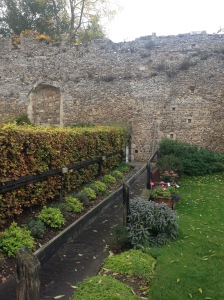
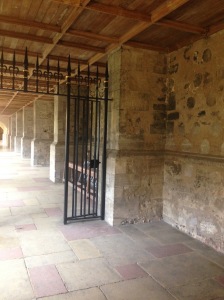

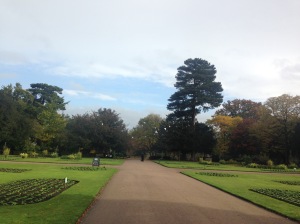
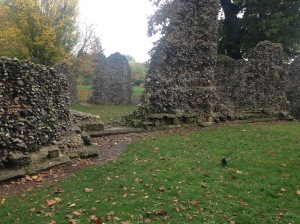


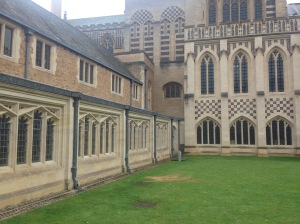



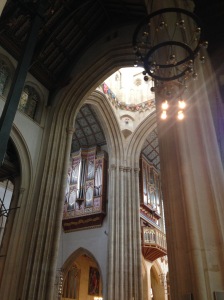
Magnificent photos.
LikeLiked by 1 person
I love the story and awesome shots! 🙂
LikeLiked by 1 person
Love history & beautiful architecture. Your post entertained & satisfied for both.
LikeLike
I was inspired today by the enlightening quote you selected from an intriguing Philosopher featured on your site. Look forward to enjoying more posts in the year ahead. Good wishes. Lita
LikeLike
A fascinating illustrated story – thanks Lita
LikeLiked by 1 person
That was a treat. Thanks!
janet
LikeLike
I just caught up with the latest captures of architecture on your site. Such a delightfully detailed feature of Doors and what they add to a building. Wishing you a great weekend up ahead. Lita
LikeLike
And the same to you, Lita. I appreciate you dropping by. The Thursday Doors challenge is so much fun. I have a link to Norm’s site in the post now if you want to see any more entries. Or here’s the InLinkz link: http://www.inlinkz.com/new/view.php?id=602528.
LikeLiked by 1 person
Thanks for the history and the nice photos.
LikeLike
I love the composition in your recent post. What a great city to enjoy and you capture it so well!
LikeLiked by 1 person
Great architecture. Spooky or not?
LikeLiked by 1 person
I think the ruins would definitely be creepy at night and the acoustics of the building also had a spooky feel to them. I loved your post on the architecture of Sri Lanka. Wishing you a great weekend.
LikeLike
Great photos! 🙂
LikeLiked by 1 person
Thank you Norma. Wishing you a lovely weekend.
LikeLiked by 1 person
Your photos highlight beautifully this piece of history. Well done Lita.
LikeLiked by 1 person
Now that’s a beautiful place, and somewhere I haven’t visited yet. Compared to Canada, England is so small, and I live there half the time, but so many places to see! 😀 Lovely post.
LikeLike
Lucky you 😉 How awesome to have roots in two contrasting land masses! Here’s to a great year ahead.
LikeLike
Very nice presentation 🙂
LikeLike
I enjoyed your recent post on your exciting travel blog. Thank you for sharing such beautiful destinations.
LikeLiked by 1 person
Thank you for this historical trip !! The photos are spectacular Lita 🙂
Have a wonderful week ahead ❤
LikeLiked by 1 person
I love beautiful churches. This is an interesting story, and your photos capture the cathedral’s majesty.
LikeLike
Thank you for your kind words. Wishing you a wonderful holiday and look forward to enjoying more of you site in 2016!
LikeLiked by 1 person
Fascinating, enjoyed the photo interpretation
LikeLike
Thank you. The story definitely caught my imagination! You have a beautiful website. I enjoyed the capture of light shining through the grass on your recent post. Wishing you a lovely December.
LikeLike
Beautiful selection of images. You go from an ancient battlefield to the peace of gardens and church. I love learning about England’s long history, the Roman and Saxon conquests and how they were fought off. And the structures were, wisely, kept intact. Great storytelling!
LikeLiked by 1 person
Thank you Linda for your beautiful comment. I agree it is wise move to keep all the structures as they are. I noticed scaffolding on the outside of the tower so renovation must be going on at the Abbey which is good to know. I am thrilled to hear we have our interest in history in common. It’s amazing to track back at how a city was formed. I remain grateful for the insightful updates you post on the most exciting city on the planet. NYC!
LikeLiked by 1 person
I know modern life can be difficult and challenging but my goodness life was tough back then! Great story & photos.😊
LikeLiked by 1 person
Wow so true. Hadn’t thought of it that way. Part of me admires how simple life was in Saxon Britain but watch out for those shiny swords ay?! Yep. I think I will take modern life. No wonder we live longer now 😉 Wishing you a wonderful weekend, your blog is gorgeous!
LikeLiked by 1 person
Europe has a rich history, like this one. Lovely pictures!
LikeLiked by 1 person
Thank you. I had great joy taking them. I think I caught the last of the British sunshine as there has been so much rain recently. I enjoy European gardens and one day hopefully I get to visit gardens further afield!
LikeLiked by 1 person
Makes me think of The Secret Garden book!
LikeLike
Wow. I love The Secret Garden, such a beautiful book. Makes me realise all secret gardens are pretty amazing! Wishing you a lovely weekend.
LikeLiked by 1 person
Love the story & the pictures of the place. Thanks!😃
LikeLiked by 1 person
A pleasure. Lovely to hear from you and catch up with your news and thought provoking posts over on Globalresidence blog.
LikeLiked by 1 person
Many thanks for always passing by & for your comments. Never fail to uplift me! 😃 Once again thanks, Lita.
LikeLike
🙂 🙂
LikeLiked by 1 person
Always a great pleasure to pass by your site, Lita.
Your posts makes for easy reading. Love how you weave the history into a story and the place where it happen.
LikeLike
Hey, it´s been a long time since the last post! Feel like sharing any news? 🙂
LikeLiked by 1 person
Thank you for this timely reminder! Yes, Christmas certainly makes time spin by. I have had an interesting month in Italy so will try to dig out some photos that have a nice sunny feeling about them. I could do with looking at some blue skies 😉 I enjoyed your image of ‘Contrasts’ and the gorgeous words that you wrote with it. Lovely post!
LikeLiked by 1 person
Oh, I´m looking forward to that, here the sky is all grey…and thank you 🙂
LikeLiked by 1 person
Thank you for the walkthrough of this bit of history…I have a growing interest in British and Nordic pasts.
LikeLike
Me too. Nordic history is full of strength and hard won battles in my opinion, it’s hard to resist reading more about epic adventures! I am enjoying your beautiful blog. Thanks for the insight into the planetarium.
LikeLiked by 1 person
Well illustrated and very informative. I enjoyed reading this .
LikeLiked by 1 person
Thank you Helen! I had a great time on your blog today, I love the way your title ‘Photophile’ has two different meanings that come together beautifully in your work. Here’s to a great weekend up ahead.
LikeLiked by 1 person
Thanks Lita for your encouraging comments. I’m enjoying your blog too. I’ve recently moved to England from Scotland and am developing an interest in English history. We’ve never had Saxons north of the border! 😉
LikeLiked by 1 person
Wow…. I felt as though I’m on a guided tour…. It was a treat reading it. Though slightly spooky… But great read through
LikeLike
Thank you so much. I guess the gothic building starts that spooky feeling going !
LikeLiked by 1 person